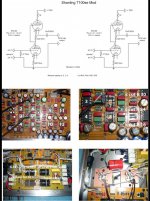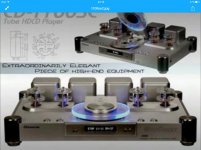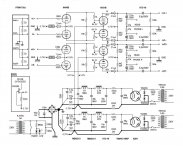hi,
I am starting this thread for recommendations on a Tube IV stage.
I came across Lampizator and Broskie cathode follower during my search as two designs.
Wondering if someone can explain how they are different?Is there any other that are out there that I have not heard off?
Also wondering if Jfet IV stage known as FETishizator http://tubeclinic.com/ is a replacement for the above IV stages?
I am starting this thread for recommendations on a Tube IV stage.
I came across Lampizator and Broskie cathode follower during my search as two designs.
Wondering if someone can explain how they are different?Is there any other that are out there that I have not heard off?
Also wondering if Jfet IV stage known as FETishizator http://tubeclinic.com/ is a replacement for the above IV stages?
Well, that makes it a bit easier.
I've played with the PCM1794 a bit in the past, and can tell you that while the reference circuits in the datasheet work very well, the best thing you can do with these chips is go dual mono with one PCM chip per channel. Much better noise and not much more complex.
I had excellent results with OpAmps, even using the humble-but-great OPA2132P and basic metal-film resistors. After a great reference to work with, of course the time for tubes had come, so I started experimenting with different tube-based designs. Many designs simply attach a tube to the output of a passive I/V stage, which while it works, is a bit of a kludge. I played around a bit with doing a grounded-grid with the cathode resistor of the tube being used as the I/V resistor, with pretty good results, and using a capacitor across the plates of both tubes to limit the high frequency response. I used the subminiature JAN 6111WA tube and found the gain to be useful, since a smaller voltage at the output of the PCM is better for sound quality, allowing you to crank the current down a bit.
If you still want to just spit the signal from a passive I/V into a tube, well, here's a paper talking some about passive stages-
http://www.ti.com/lit/an/slaa399/slaa399.pdf
A low input impedance passive I/V with something similar to a low-noise phonostage would probably work very well, even if a bit inelegant, just keep the noise down.
If I were to do it again (and I am, dual mono PCM1794, DIR9001, maybe an ASRC of some sort, but I want to build up a nice dual 1794 PCB, since they aren't easy to find already in a dual mono config without stacking boards) I would design around doing some sort of grounded grid tube differential input with a low plate resistance, high transconductance tube (such as a 6DJ8/6922, although a workable circuit could be done with the 6SN7 or similar at higher voltage without as easy design) or maybe use a transformer input. Run the tube nice and hot with a lower bias voltage and supply, and use a small cathode resistor to receive the output from the DAC. Alternatively, terminating the DAC outputs into a low-value (33~56 ohm) resistor, and running a high-mu differential pair off of it might work well, such as the Tubecad circuit shown below in the links.
The thing that makes interfacing tubes to the PCM1794 a bit tricky is that this chip likes to see a low impedance at its output, so its not as simple as just inputting the signal to a grid resistor and calling it done. John Broskie over at the Tubecad journal has written a dozen or so blogs on the subject, and goes into detail on some workable implementations...
DACs & Tubes and Bodies & Tubes
Balanced-Ouput DACs and Tubes and Aikido
The unbalancer looks promising, maybe with a 6N2P or (maybe) even 12AT7 or 6SL7 with lower peak output, and a better CCS than that LM334-
The Unbalancer
I've played with the PCM1794 a bit in the past, and can tell you that while the reference circuits in the datasheet work very well, the best thing you can do with these chips is go dual mono with one PCM chip per channel. Much better noise and not much more complex.
I had excellent results with OpAmps, even using the humble-but-great OPA2132P and basic metal-film resistors. After a great reference to work with, of course the time for tubes had come, so I started experimenting with different tube-based designs. Many designs simply attach a tube to the output of a passive I/V stage, which while it works, is a bit of a kludge. I played around a bit with doing a grounded-grid with the cathode resistor of the tube being used as the I/V resistor, with pretty good results, and using a capacitor across the plates of both tubes to limit the high frequency response. I used the subminiature JAN 6111WA tube and found the gain to be useful, since a smaller voltage at the output of the PCM is better for sound quality, allowing you to crank the current down a bit.
If you still want to just spit the signal from a passive I/V into a tube, well, here's a paper talking some about passive stages-
http://www.ti.com/lit/an/slaa399/slaa399.pdf
A low input impedance passive I/V with something similar to a low-noise phonostage would probably work very well, even if a bit inelegant, just keep the noise down.
If I were to do it again (and I am, dual mono PCM1794, DIR9001, maybe an ASRC of some sort, but I want to build up a nice dual 1794 PCB, since they aren't easy to find already in a dual mono config without stacking boards) I would design around doing some sort of grounded grid tube differential input with a low plate resistance, high transconductance tube (such as a 6DJ8/6922, although a workable circuit could be done with the 6SN7 or similar at higher voltage without as easy design) or maybe use a transformer input. Run the tube nice and hot with a lower bias voltage and supply, and use a small cathode resistor to receive the output from the DAC. Alternatively, terminating the DAC outputs into a low-value (33~56 ohm) resistor, and running a high-mu differential pair off of it might work well, such as the Tubecad circuit shown below in the links.
The thing that makes interfacing tubes to the PCM1794 a bit tricky is that this chip likes to see a low impedance at its output, so its not as simple as just inputting the signal to a grid resistor and calling it done. John Broskie over at the Tubecad journal has written a dozen or so blogs on the subject, and goes into detail on some workable implementations...
DACs & Tubes and Bodies & Tubes
Balanced-Ouput DACs and Tubes and Aikido
The unbalancer looks promising, maybe with a 6N2P or (maybe) even 12AT7 or 6SL7 with lower peak output, and a better CCS than that LM334-
The Unbalancer
Do you know any dual mono implementation of this DAC?
I have a PCB of unbalancer I planned to use as a buffer stage before.
I have to admit I am not good myself in designing something. I can try to copy a design perhaps.
Lingwendil is it possible to share the circuit designs which does not need much modifications if any with me?
I have a PCB of unbalancer I planned to use as a buffer stage before.
I have to admit I am not good myself in designing something. I can try to copy a design perhaps.
Lingwendil is it possible to share the circuit designs which does not need much modifications if any with me?
Do you know any dual mono implementation of this DAC?
I have a PCB of unbalancer I planned to use as a buffer stage before.
I have to admit I am not good myself in designing something. I can try to copy a design perhaps.
Lingwendil is it possible to share the circuit designs which does not need much modifications if any with me?
The only good PCM1794 design I know of that is dual mono already is this one, and it is argualbly one of the best if you want to follow it with something like the unbalancer, it is not very simple however-
DDDAC 1794 NOS DAC - Non Oversampling DAC with PCM1794 - no digital filter - modular design DIY DAC for high resolution audio 192/24 192kHz 24bit
It has a good long thread to read through as well, and a few others have done exactly what you want to do...
http://www.diyaudio.com/forums/digital-line-level/224108-nos-192-24-dac-pcm1794-waveio-usb-input.html
Here is another tube I/V for balanced current output DAC:
http://www.diyaudio.com/forums/digi...s-valve-output-stage-lundahl-transformer.html
http://www.diyaudio.com/forums/digi...s-valve-output-stage-lundahl-transformer.html
Koifarm can you please share your design here?
I used 6n6p tubes, same schematic other pinout.
I/V resistor on Iout from dac and analoge ground.
Not the technical best solution but simple and good sounding.
Cd player has dual pcm1792.
Attachments
Last edited:
You can find a lot of info here.
http://www.dddac.com/documents/dddac1794_nos_ver30.pdf
For I/V resistor calculation sample:
required output voltage = 2Vrms
Tubestage amplification(6n6p in srpp) = 11 x
U at I/V resistor = 2/11= 182 mV
With two outputs from pcm1794 in parallel(Dual mono)I max will be 15.6mA so I/V resistor to start with is 182/15,6= 11.7Ohm.
http://www.dddac.com/documents/dddac1794_nos_ver30.pdf
For I/V resistor calculation sample:
required output voltage = 2Vrms
Tubestage amplification(6n6p in srpp) = 11 x
U at I/V resistor = 2/11= 182 mV
With two outputs from pcm1794 in parallel(Dual mono)I max will be 15.6mA so I/V resistor to start with is 182/15,6= 11.7Ohm.
Last edited:
My 2 cents!
I use a modified PCIe sound card - asus essense stxii. It has a mono stereo PCM 1792a - the "software control" version of PCM 1794 - from which I take signal through 2 ohm I/V resistors to feed a differential tube stage. I' ve designed it by my own and it reflects my limited level on electronics. My conclusion is that this chip likes the very small I/V resistor - also tested with 56 and 82 ohm - but then enough gain is required. Now I have replaced the tube stage with this http://www.diyaudio.com/forums/analog-line-level/296406-salas-dcg3-preamp-line-headphone-122.html. Eventually, solid state wins but I feel very nice to know that my tubes came close
I use a modified PCIe sound card - asus essense stxii. It has a mono stereo PCM 1792a - the "software control" version of PCM 1794 - from which I take signal through 2 ohm I/V resistors to feed a differential tube stage. I' ve designed it by my own and it reflects my limited level on electronics. My conclusion is that this chip likes the very small I/V resistor - also tested with 56 and 82 ohm - but then enough gain is required. Now I have replaced the tube stage with this http://www.diyaudio.com/forums/analog-line-level/296406-salas-dcg3-preamp-line-headphone-122.html. Eventually, solid state wins but I feel very nice to know that my tubes came close
Attachments
This is the DAC output stage I have in mind.
RuSubMin-Audio
In case you don't see the link search tubeclinic.com and look under nitro.
RuSubMin-Audio
In case you don't see the link search tubeclinic.com and look under nitro.
- Status
- This old topic is closed. If you want to reopen this topic, contact a moderator using the "Report Post" button.
- Home
- Amplifiers
- Tubes / Valves
- Tube IV stage



